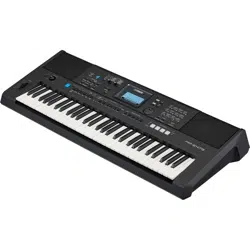Loading ...
Loading ...
Loading ...

Connecting to External Devices
PSR-E473, PSR-EW425 Owner’s Manual
55
For details about how to connect to a smart device,
refer to the Smart Device Connection Manual on the
website (page 11).
Transferring Files (including Songs and
Styles)
You can transfer a MIDI file to the instrument and
play it as a downloaded song, or transfer a Style file
to the instrument and use it as a built-in Style. You
can also transfer and store backup files to a different
device.
When transferring files to and from a computer:
Turn on “Storage Mode” (page 66, Function 076) in
Function Settings to use the instrument as an exter-
nal storage device.
When transferring files to and from a smart device:
Use the “MusicSoft Manager” app. Refer to the fol-
lowing website for details.
https://www.yamaha.com/kbdapps/
Sending and Receiving MIDI Data
You can listen to MIDI files played on a computer or
smart device through the instrument’s speakers, or
send a performance on the instrument as MIDI data
to a computer or smart device.
Sending and Receiving Audio Data
(USB Audio Interface Function)
You can listen to audio files played on a computer or
smart device through the instrument’s speakers, or
send a performance on the instrument as audio data
to a computer or smart device.
A driver must be installed to send/receive audio data
to/from a computer running on Windows. For details,
refer to the Computer-related Operations document
on the website (page 11).
Using Smart Device Apps
Using smart device apps with the instrument
expands the range of possibilities, such as recording
and immediately sharing a performance.
Please refer to the following website for information
about compatible smart devices and apps.
https://www.yamaha.com/kbdapps/
• Use an AB type USB cable of less than 3 meters.
• USB 3.0 cables cannot be used.
• Only turn on Storage Mode when transferring files to and from a
computer. While Storage Mode is on, you cannot play or operate
the instrument, or send/receive MIDI data and audio data.
• The maximum file size that can be transferred to the instru-
ment is approximately 1.72 MB in total.
• The files transferred to the instrument are sorted according to the
following file name order: symbol
→
number
→
alphabet.
Files that can be transferred
• MIDI files (Extension: .MID)
MIDI files that have been created with other instru-
ments or computers can be transferred to this instru-
ment as Songs.
• Style files (Extension: .STY)
Style files that have been created with other devices
can be transferred to this instrument.
• Backup files (Extension: .BUP)
Data in the instrument can be saved as a single
backup file. For details about what information is
saved, refer to “Backup Data” (page 68).
USB cable
USB terminal
InstrumentComputer
[USB TO HOST]
terminal
NOTICE
NOTE
• With this instrument, User Songs cannot be transferred to
external devices via the [USB TO HOST] terminal. To export
User Songs, save them to a USB Flash Drive (page 59).
• The maximum size of a single Style file is 50 KB. Files that
exceed this limit will not be recognized by the instrument.
If you are using a DAW (digital audio workstation) with this
instrument, set “Audio Loop Back” (page 66, Function 070)
to OFF.
If the function is instead set to ON, a mixture of audio data
and instrument audio will be sent to the DAW, which might
cause feedback and noise.
• The volume can be adjusted on the computer or smart device,
and also by using the instrument’s [MASTER VOLUME] con-
trol. In addition, you can adjust the volume of the audio input
from the [USB TO HOST] terminal in the Function Settings
(page 66, Function 069).
• When outputting audio playback from the instrument to a
computer, such as when layering audio input from the [USB
TO HOST] terminal over performance audio from the instru-
ment and recording it to a computer, the [MASTER VOLUME]
control cannot be used to adjust the volume.
NOTE
NOTICE
NOTE
Loading ...
Loading ...
Loading ...
